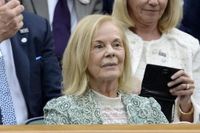The British royal family and much of the nation are mourning the passing of Katharine, Duchess of Kent, who died peacefully at her Kensington Palace home on the evening of September 4, 2025, surrounded by her family. At 92, the Duchess leaves behind a legacy as one of the most quietly influential and compassionate figures in modern British royal history. Her death marks not only the end of an era but also a poignant chapter for the monarchy, as she was the first senior royal to convert to Catholicism since the 17th century.
Born Katharine Lucy Mary Worsley on February 22, 1933, she was raised in Yorkshire as the only daughter of Colonel Sir William Worsley and Lady Worsley of Hovingham Hall. Her aristocratic upbringing did little to shield her from the hardships of life, and those experiences would later shape her empathy and approach to service. In 1961, she married Prince Edward, Duke of Kent, a grandson of King George V and first cousin to Queen Elizabeth II, in a grand ceremony at York Minster. She became the first woman without a peerage or princess title at birth to marry a royal duke in more than a century, as reported by the National Catholic Register.
For decades, the Duchess was a familiar figure at public engagements, often representing the Queen at charity and state events both at home and abroad. Her devotion to service was matched only by her passion for music and her deep empathy for young people. As Buckingham Palace noted in its official statement, "The King and Queen and all members of the Royal Family join the Duke of Kent, his children and grandchildren in mourning their loss and remembering fondly the Duchess’s lifelong devotion to all the organizations with which she was associated, her passion for music, and her empathy for young people."
Yet, her journey was far from smooth. The Duchess faced profound personal losses, including a traumatic episode in 1975 when, while pregnant with her fourth child, she contracted measles and, following medical advice, had to terminate the pregnancy. Two years later, she suffered the heartbreak of a stillbirth at 36 weeks. According to the National Catholic Register, she described the miscarriage as "devastating" and, for a time, viewed it as punishment for the earlier abortion. These tragedies led her to develop a deep empathy for others who had experienced similar losses, and she became a vocal supporter of those who fight to protect life and the family.
Amidst her personal struggles, the Duchess found herself increasingly drawn to the Catholic faith, especially as the Church of England wrestled with internal debates over issues like the ordination of women clergy. Her spiritual journey culminated in January 1994 when she was received into the Catholic Church by Cardinal Basil Hume, then-Archbishop of Westminster. It was a moment of historical significance: no senior royal had publicly converted to Catholicism since 1685, and the Act of Settlement of 1701 still barred royals who became or married Catholics from the line of succession. She once told the BBC, "I do love guidelines and the Catholic Church offers you guidelines. I have always wanted that in my life. I like to know what’s expected of me."
The impact of her conversion rippled through the royal family and beyond. In 2001, her son, Lord Nicholas Windsor, followed her example, becoming the first male blood member of the royal family to become a Catholic since King Charles II’s probable deathbed conversion in 1685. Her faith continued to guide her actions, from regular pilgrimages to Lourdes to frequent attendance at Mass at the Brompton Oratory in London.
Despite stepping back from public royal duties in 2002, the Duchess remained closely involved with a host of charitable organizations. She was a patron of the Samaritans, volunteered as a Unicef ambassador, and in 2004 co-founded Future Talent, a charity dedicated to helping young musicians from disadvantaged backgrounds. The organization, whose ambassadors include Sting, works to break down barriers for children from low-income families by assisting with instrument purchases and funding music lessons.
Her passion for music was not limited to high-profile events or elite circles. After a visit to Wansbeck Primary School in Hull in 1996, she quietly began teaching music there, offering weekly 40-minute lessons and working with the school choir. Known simply as "Mrs. Kent," she spent 13 years at the school, her true identity known only to the headteacher. In a 2022 interview, she reflected, "Only the head knew who I was. The parents didn’t know, and the pupils didn’t know. No one ever noticed. There was no publicity about it at all — it just seemed to work." She also taught part-time at a school attended by children who lived in Grenfell Tower and attended a memorial service at the base of the high-rise in 2018 to mark the first anniversary of the fire that claimed 72 lives, as reported by the Evening Standard.
The Duchess’s compassion was perhaps most publicly on display during her many years presenting trophies at Wimbledon, where she became famous for consoling losing finalists. Her embrace of a tearful Jana Novotná in 1993, after the Czech player narrowly lost the women’s singles final, became an iconic image of empathy and grace. As the Evening Standard noted, she "put aside royal formalities in 1993, hugging a tearful Jana Novotna after she lost the ladies' singles final to Steffi Graf."
Her later years were marked by both physical and emotional challenges, including battles with depression, nervous strain, gallbladder problems, treatment for an ovarian cyst, and symptoms of the Epstein-Barr virus. Yet, through it all, she remained steadfast in her commitment to helping others, particularly young people and those in need.
Following her death, royal mourning was approved by His Majesty the King and will continue until the day of her funeral. During this period, members of the royal family and staff wear clothing that pays appropriate tribute, and those in livery, the Royal Mews, and troops on public duties wear black armbands. The Duke of Sussex sent his condolences privately and will continue with his planned engagements, including the WellChild Awards.
The funeral, which will be the first Catholic funeral for a member of the royal family in modern British history, is set to take place at Westminster Cathedral in the coming weeks. The Palace has indicated that arrangements will reflect the Duchess’s personal wishes, and an online Book of Condolence is expected to be opened for the public to share their memories and tributes.
Tributes have poured in from across Britain and beyond. The Prince and Princess of Wales wrote, "The Duchess worked tirelessly to help others and supported many causes, including through her love of music. She will be a much missed member of the family." Cardinal Vincent Nichols of Westminster remembered "her presence in our community, especially her participation in the pilgrimage to Lourdes, as well as her lifetime of public service." And British Catholic broadcaster Colin Brazier summed up a common sentiment, writing, "In a world of bombast, self-promotion, and vanity, Katharine Worsley was that rarest of things: a public figure of genuine humility, even holiness."
The Duchess of Kent’s legacy endures in the lives she touched—whether through music, charity, or a simple gesture of kindness on a summer afternoon at Wimbledon.




